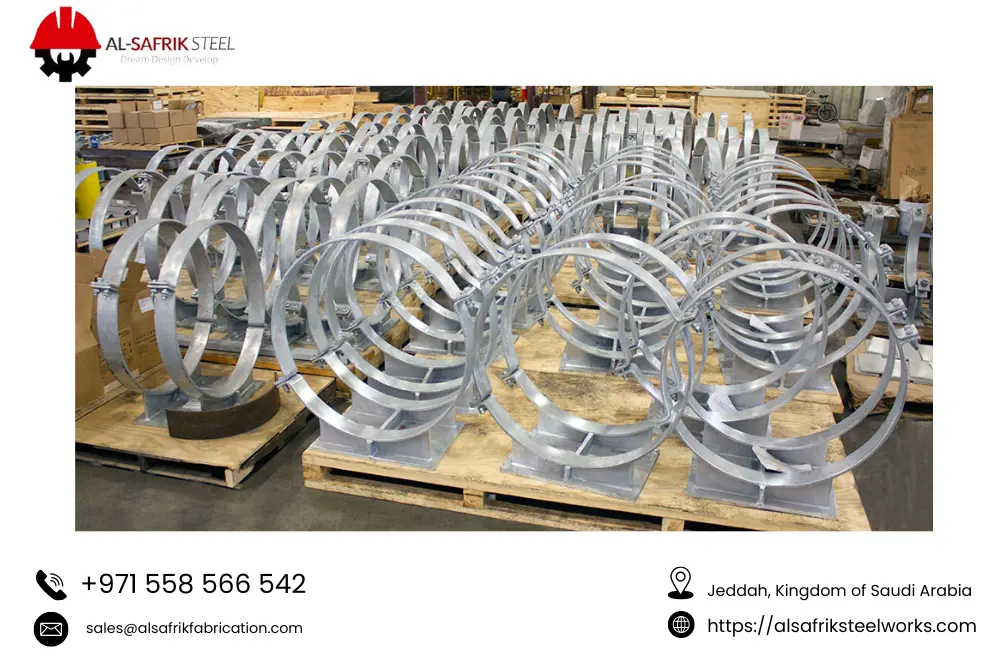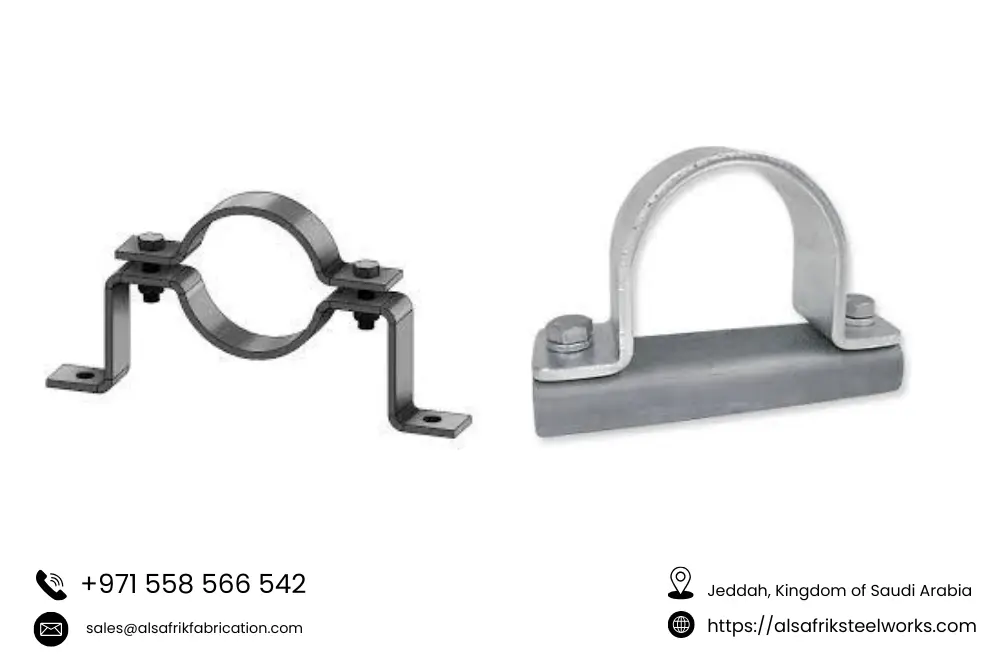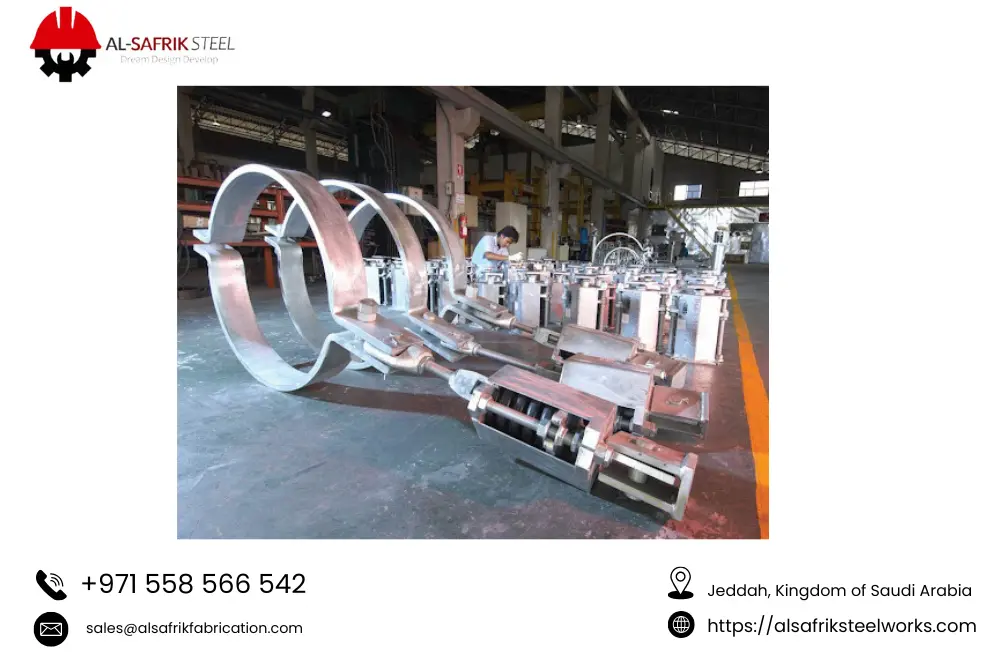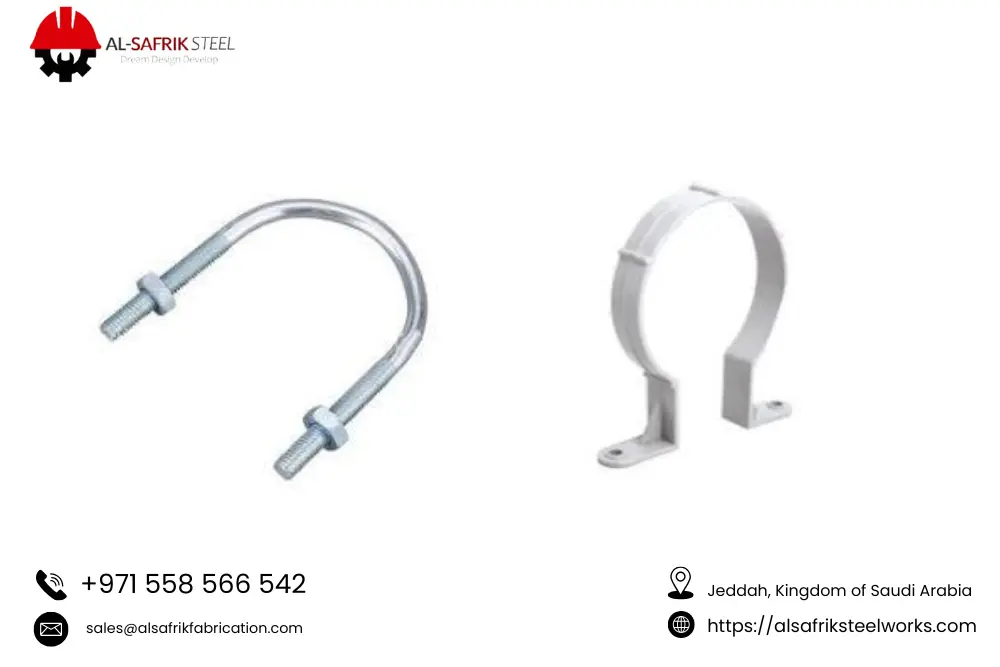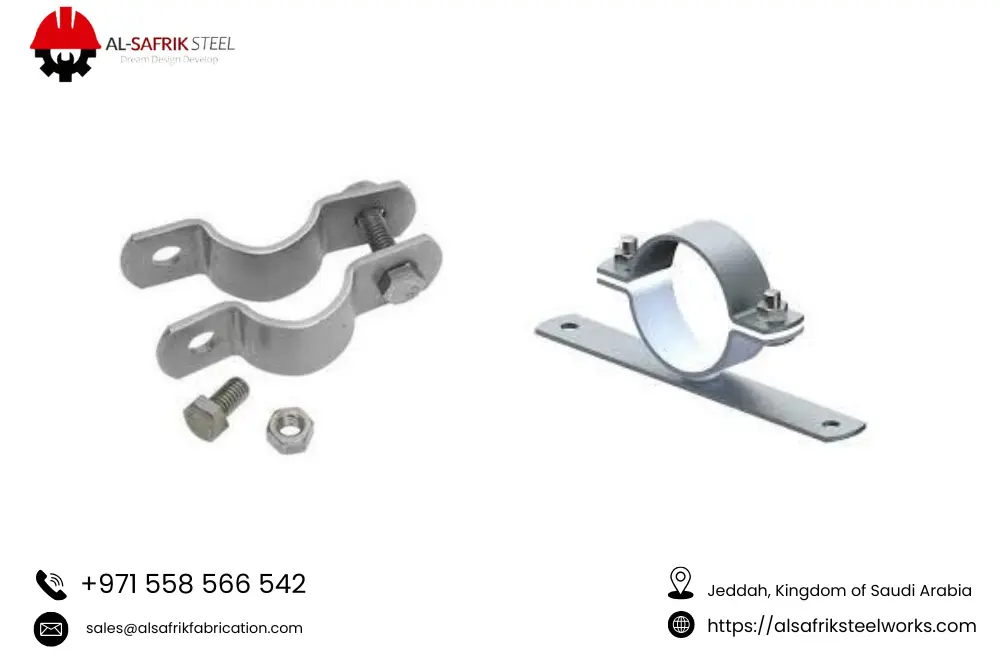Pipe Clamps
Pipe clamps are essential fastening tools designed to stabilize and prevent unwanted movement. These clamps are used to secure and support pipes in various industries. They come in different sizes, materials, and styles to accommodate multiple pipe diameters and environments. Whether used for securing pipelines in mechanical systems, suspending pipes in HVAC installations, or reducing vibration in heavy-duty applications, pipe metal clamps play a crucial role in maintaining the integrity and efficiency of piping systems. Al Safrik Steel in Saudi Arabia manufactures steel-fabricated clamps that provide durability, ease of installation, and adaptability. The following features of pipe metal clamps make them a fundamental component in modern infrastructure and engineering projects.
Types of Pipe Clamps
Several types of pipe metal clamps are designed for specific applications. Here are some of the most common types

Cushion Pipe Clamps
Also known as vibration-damping clamps, these come with rubber or plastic cushioning to absorb shock and vibration, protecting the pipe and the support structure. They are widely used in hydraulic and pneumatic systems.

Rigid Clamps
These clamps provide firm and fixed support, preventing pipe movement. They are often used in permanent installations where pipes must remain securely.

Split Ring Clamps
This type of clamp consists of two semicircular rings bolted together, allowing easy installation and removal. It is commonly used in plumbing and HVAC systems.

Heavy-Duty Pipe Clamps
Made from strong materials like stainless steel or cast iron, these clamps are designed for high-pressure or large-diameter pipes in industrial settings.

P-Clamps (P-Style Clamps)
P-clamps have a single mounting hole and a curved shape that wraps around the pipe. They are commonly used in electrical and automotive applications for securing wires, hoses, and tubing.

Saddle Clamps
They secure pipes to flat surfaces, often in outdoor or exposed installations, and are popular in agricultural irrigation and drainage systems.

Swivel Pipe Clamps
Swivel clamps allow some movement, making them ideal for flexible piping systems. They are used in applications where pipes may expand or contract due to temperature changes.

Adjustable Pipe Clamps
These clamps can be tightened or loosened to accommodate different pipe sizes, offering versatility in various applications.

Standard Pipe Clamps
These are the most basic clamps for securing pipes to walls, ceilings, or floors. They come in different sizes and materials, such as plastic, stainless steel, or galvanized steel.

U-Bolt Clamps
Shaped like a "U" with two threaded ends, U-bolt clamps fasten pipes to structures or other objects. They are commonly used in automotive, plumbing, and industrial applications.
Applications of Pipe Clamps
They are widely used in various industries because they secure and support pipes efficiently. Their applications range from residential plumbing to heavy industrial installations. Below are some key areas where these clamps are essential:
Plumbing and Piping Systems:
Used to secure water and gas pipes in residential, commercial, and industrial buildings. They prevent pipe movement, reduce stress on joints or fittings, and help maintain the proper alignment of pipes in plumbing installations.
HVAC (Heating, Ventilation, and Air Conditioning) Systems:
Supports air ducts and refrigerant piping in HVAC systems to reduce vibration and noise caused by moving air and fluids. Ensuring proper insulation and spacing for energy efficiency.
Industrial Applications:
Used in oil and gas pipelines, chemical processing plants, and power plants to secure pipes carrying liquids and gases. The heavy-duty clamps ensure structural stability and prevent pipe displacement, and cushion clamps reduce vibration and noise in industrial environments.
Construction and Infrastructure:
These clamps support pipes in bridges, tunnels, and high-rise buildings to ensure stability and safety in water supply and drainage systems. They are also used in the installation of fire sprinkler systems.
Marine and Offshore Applications:
They are well-utilized in ships, submarines, and offshore oil rigs for securing pipes in harsh environments. Corrosion-resistant pipe clamps are preferred to withstand salty and humid conditions.
Agricultural and Irrigation Systems:
In agriculture systems, these clamps prevent pipe misalignment and leaks in water distribution networks and help secure pipes in irrigation and drainage systems for farms and plantations.
Medical and Laboratory Equipment:
They ensure precise alignment of oxygen and medical gas pipelines, supporting gas and fluid transfer pipes in hospitals and research laboratories.
Renewable Energy and Solar Panel Installations:
Used in solar farms to secure piping for coolant systems and ensures proper mounting of pipes in geothermal and hydroelectric power plants.
Simply, pipe clamps play a crucial role in multiple industries by providing piping systems stability, durability, and security. Choosing the right clamp type ensures efficient operation, reduced maintenance costs, and increased safety in various applications.
Installation Guide for Pipe Clamps:
Proper installation is crucial for ensuring the longevity and stability of these clamps. Here’s a step-by-step guide:
Step 1: Choose the Right Pipe metal Clamp:
- Select the appropriate type based on the pipe material, size, and application.
- Ensure the clamp is compatible with environmental conditions (e.g., corrosion-resistant for outdoor use).
Step 2: Measure and Mark the Installation Points:
- Measure the pipe’s diameter and mark the exact positions where the clamps will be installed.
- For horizontal pipes, ensure equal spacing between clamps to distribute weight evenly.
Step 3: Secure the Clamp to the Surface:
- Use appropriate anchors, bolts, or screws to fix the clamp to walls, ceilings, or floors.
- For heavy-duty installations, ensure the support structure can bear the pipe’s load.
Step 4: Insert and Fasten the Pipe:
- Place the pipe into the clamp and tighten the fasteners securely but not excessively to avoid damaging the pipe.
- If using cushion clamps, ensure the rubber lining fully contacts the pipe to minimize vibration.
Step 5: Check Alignment and Stability:
- Ensure the pipe is aligned correctly with the rest of the system.
- Test for any movement or instability and make adjustments if necessary.
Step 6: Final Inspection and Testing:
- Inspect all connections to confirm that the clamp holds the pipe firmly.
- If applicable, test the system under working conditions to ensure stability.
Why choose Al Safrik Steel?
As a well-known steel fabricator company in Saudi Arabia, we offer regional industrial products. If you are considering purchasing pipe clamps for your project, here’s why we are a great choice:
- We maintain high-quality manufacturing that meets international standards such as ISO, ASTM, and DIN. Our clamps are made from premium-grade steel and other alloys, ensuring excellent strength and longevity.
- Provides a wide range of products with multiple types so customers can find the perfect product for their commercial applications.
- We have advanced manufacturing technology, including CNC machining, laser cutting, and robotic welding, ensuring precision and consistency in every product.
- If you need custom-designed pipe clamps for specific applications, we provide tailor-made solutions to meet unique requirements.
Moreover, being based in Saudi Arabia allows Al Safrik Steel to quickly supply products across the GCC (Gulf Cooperation Council) region, reducing shipping time and costs for local buyers.

